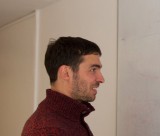The University of Nottingham
 Exchange online
Exchange online
Research Exchange
How is influenza transmitted between people?

A major new study will further uncover how the influenza virus is transmitted between people.
The Evaluating Modes of Influenza Transmission (EMIT) study will see researchers administer flu virus to people in a quarantined setting, enabling them to further examine how influenza is transmitted from person to person, potentially impacting on how the spread of illness is prevented in the future.
The study is being led by the Health Protection and Influenza Research Group (HPIRG) at The University of Nottingham, which focuses on influenza transmission. The group will also coordinate the efforts of the EMIT Consortium which is a group of partners from the UK, the USA, Australia and Canada.
Major funding
The consortium has received a £6.7million research grant from the US Centres for Disease Control and Prevention to carry out its research, which is due to start in March 2013. The consortium is made up of a number of partners around the UK together with collaborators from across globe spanning multiple disciplines such as physicians, epidemiologists, infection control building engineers, aerobiologists and mathematical modellers.
The HPIRG is led by Professor Jonathan Van-Tam, of The University of Nottingham’s School of Community Health Sciences and the Health Protection Agency East Midlands.
Professor Van-Tam said: “People could argue that the transmission of influenza between humans is very clear — through coughing and sneezing, but it’s what lies beneath that cough or sneeze which is important. We need to know if it’s big particles (large droplets) or tiny particles (aerosols) which are important in the transmission of the virus, as this will affect whether nursing and medical staff should wear a simple face mask or a respirator, for instance, when treating people with this condition.”
Transmission between people
The work being carried out by the EMIT Consortium is divided into three parts. Stage one, which is being undertaken by scientists at the University of Maryland in the US, will examine what happens when people cough or sneeze and how infectious the different sized particles are when released. Evidence will be generated using people who have contracted flu naturally as well as those who have been deliberately infected with the virus in a controlled environment (in the UK during stage three).
The second stage will take place at Wake Forest University in North Carolina. Here, scientists will look at devising a face shield which will prevent the large droplets from a cough or sneeze hitting the face, yet allow aerosols to travel round the back of the device. The purpose, says Professor Van Tam, is to alter how it is possible for people to get flu when they wear this shield so that the different modes of transmission can be isolated from each other.
The first two stages will feed in to the third part of the study, where scientists will give some people the influenza virus in a controlled environment in the UK and then study how it is passed to other volunteers, some of whom will wear the face shield and some of whom will not.
“At first glance, the idea of giving people flu sounds unusual, but it’s actually something that has been done for decades in carefully controlled scientific circumstances using a slightly weakened virus,” says Professor Van-Tam. “Scientists regularly give people a well-characterised flu virus to test drugs and vaccines, so we thought why can’t we turn this model on its head and give people this flu virus in the same way, but instead of studying treatment, see how it can be transmitted to other people?”
“We’ve done this once previously and the study was a huge success and was published in the Journal of Infectious Diseases1,2. We now need to refine the initial work by using the same basic model of giving people flu, and having them transmit it to others; but this time we’ll add some interventions in to block certain routes of transmission so we can learn how flu is transmitted to others (i.e. which mode of transmission is most important). That’s what we are hoping to bring together under the EMIT package.”
Flu camp
The first studies are due to begin in early March, and the team will be recruiting for three separate studies, each one requiring 45 volunteers, both male and female between the ages of 18 and 45. The volunteers will be placed in quarantine in ‘exposure rooms’, where the conditions will be maintained on the cool and dry side to give the best possible chance of flu transmission, and air-tight to avoid cross-contamination. Volunteers are well looked after and well compensated (see www.flucamp.com).
Professor Van-Tam adds: “This world-leading work is one of a kind and is absolutely unique, it is unlikely to be repeated in the foreseeable future because of the time and resources required, so it is very exciting.”
The team is hoping to have its first results by the early autumn.
Leave a Reply
Other

Top prize for quantum physicist
A University of Nottingham physicist has won a prestigious medal from the Institute of Physics for […]

Zero carbon HOUSE designed and built by students comes home
Design and construct a low cost, zero carbon, family starter home, transport it to Spain, build […]